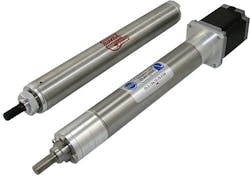The question of whether it’s better to use pneumatic or electric actuators as part of your system design or to purchase equipment featuring one type of actuator or the other does not lend itself to an easy answer. Like many of life’s decisions, the answer to this question typically begins with: “Well, it depends …”
If there is any significant performance differentiator, it is that electric actuators are better known for their high levels of precision. Though this is not to say pneumatic actuators cannot deliver very precise motion. Again, the issue here revolves around how much precision you really need.
For help on this issue, we referred to information from Bob Kral at Bimba Manufacturing Company, a supplier of pneumatic, electric and hydraulic actuators.
According to Kral, the choice of pneumatic or electric actuators involves an evaluation of performance, component costs, system costs, and productivity gains. The two technologies are so different that one cannot be a drop-in replacement for the other. Each has inherent advantages and disadvantages.
The case for pneumatic actuators
Pneumatic actuators provide high force and speed at low unit cost in a small footprint. As a matter of fact, pneumatic cylinders provide more force and speed per unit size than any other actuator technology except hydraulic. Force and speed on pneumatic actuators are easily adjustable and are independent of each other.
Pneumatic actuators are most economical when the scale of deployment matches the capacity of the compressor. Small compressors are efficient and economical when used to power a small number of pneumatic devices. Large compressors are efficient and economical when powering a large number of pneumatic devices.
Prices for non-repairable, rod-type cylinders range from $15 to $250 depending on body diameter, stroke and options.
While pneumatic component costs are low, maintenance and operating costs can be high, especially if a serious effort has not been made to quantify and minimize the costs. Maintenance and operating costs include replacement cylinder costs, air line installation and maintenance, and electricity for the compressor. According to the Department of Energy, 24 percent of the annual cost of compressed air is due to maintenance, equipment and installation while 76 percent is due directly to the cost of electricity for the compressor.
Determination of the operating cost per pneumatic device deployed in a facility can be eye opening, especially if cost calculations have not been done for a while and the scale of operations has shrunk. If there are 500 pneumatic devices using a compressor, cost per device may average $100 per year; but if there are only 50 devices, then cost per device increases ten times to $1,000.
The case for electric actuators
In contrast to pneumatics, electric actuators provide precise control and positioning, help adapt machines to flexible processes and have low operating cost. They are most economical when deployed in a moderate scale in processes where their performance advantages can be a benefit and when the electronics are separate from the actuator to segment and minimize replacement costs.
Electric actuators consist of a ball, acme or roller screw connected via a coupler to an electric motor. As the screw turns it moves a piston, which is connected to the rod or carriage. The rod or carriage moves the load. Performance varies depending on materials used.
Commonly used motors for electric actuators include steppers and servos. Brush dc motors and ac motors are sometimes used with limit switches when positioning accuracy is less critical. Step motors are an economical choice for accurate positioning at lower speeds. However, steppers may lose synchronization with the controller when employed open loop without an encoder or if they are undersized for an application. Servos, by definition, are closed loop and provide superior performance at high speeds, albeit at a higher cost. High precision screws and anti-backlash mechanics can provide accuracies to ten-thousandths of an inch. Standard precisions with standard components range from a few hundredths to a few thousandths of an inch.
Components of an electric actuator include the mechanical actuator that translates motor rotation to linear speed and thrust, the motor, an electronic driver or amplifier to power the motor, and a controller to control motion. The total cost for these components ranges from $800 to $3,000 and up.
Operating costs of electric actuators are largely due to motor power draw. Controllers’ and drivers’ low voltage circuitry consumes power to a far lesser degree.
While component costs of electric actuators are high, operating costs are low. High component costs often deter the use of electric actuators because savings in operating costs compared to pneumatics are often not adequately considered or are outright ignored.
Cost comparison
To better compare actual costs between pneumatic and electronic actuators, consider this example: Manual changeovers (adapting a production line to a different product) can be expensive in terms of both lost production and man-hours required to implement the change. Over the course of a year, if changeovers are required once a week and each changeover requires two people for four hours at $50 per hour, man-hour costs amount to $20,800 per year. If products are produced one per minute and the value of each product is $10, lost production costs amount to $124,800. The total annual cost of changeovers amounts to $145,600. Because electric actuators can substantially reduce changeover costs (largely due to the fact that they can retain condition settings), the annual cost savings associated with changeovers must be considered as part of the implementation decision.
Leaders relevant to this article:


